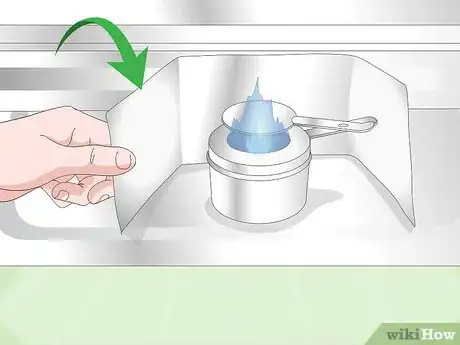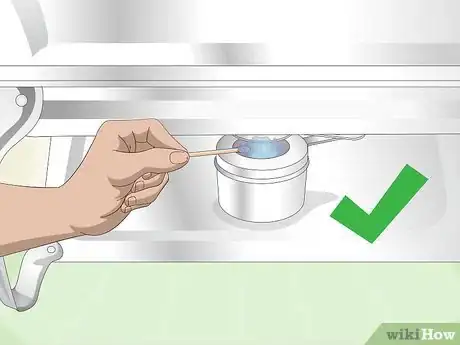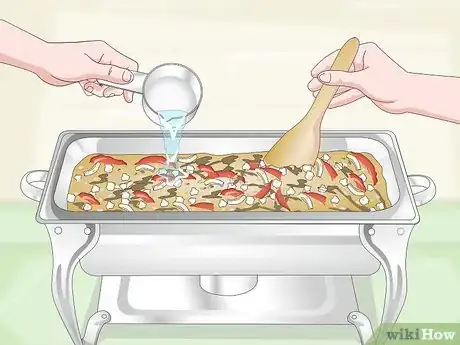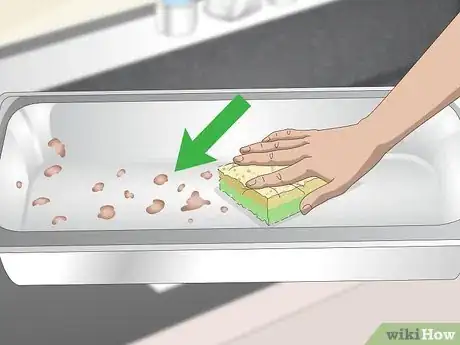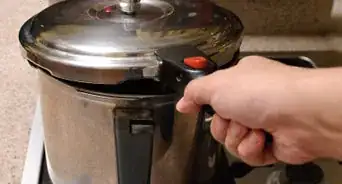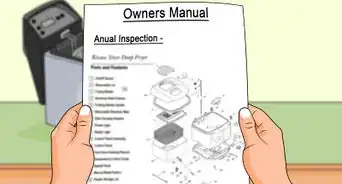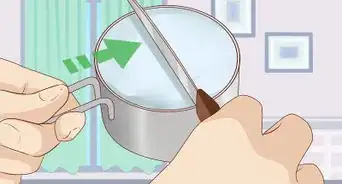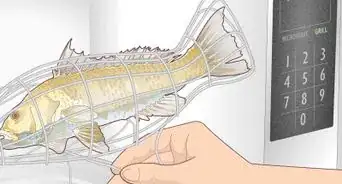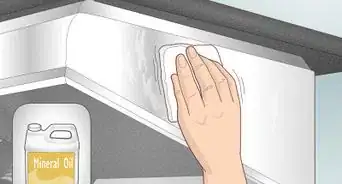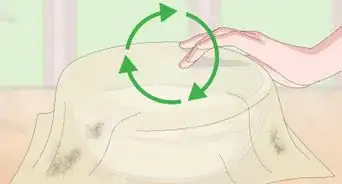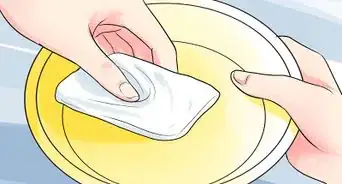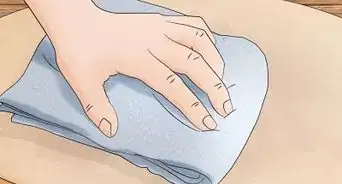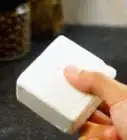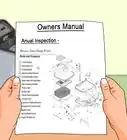This article was co-authored by Ashley Crawford. Chef Ashley Crawford is a Private Chef and the Founder of A Taste of Chef Ash. Chef Ashley started in the culinary industry when she was 14. She specializes in Creole and Cajun cuisine but has experience in all culinary topics. She has been featured in ESPN and Sports Illustrated for her culinary work with athletes.
There are 11 references cited in this article, which can be found at the bottom of the page.
This article has been viewed 75,599 times.
Chafing dishes are often known in the catering world as "a host's best friend" because they can keep your food warm for hours on end. If you're hosting a dinner party or special event, setting up and serving with a chafing dish can allow you to serve heated food for several hours. Set up your chafing dish safely on your serving table to prevent burns or spills. After you are done serving your food, clean your chafing dish thoroughly using warm water and dish soap so it is ready-to-use when you next need it.
Steps
Setting Up a Chafing Dish
-
1Place the food and water pans over the chafing dish stand. Most chafing dishes are made of 4 main components: a food pan, a water pan, a stand, and a lid. Place the water pan on the chafing dish first, then put the food pan on top. The lid will be used later when you need to cover your food to keep it from going cold.
-
2Set up your chafing dish directly where you intend to serve food. Chafing dishes are hot and unwieldy when they are in use. Carrying them after you have set them up can make you at-risk for injuries. Place your chafing dish in an upright position on the table you're serving food on to keep yourself safe.[1]
- Avoid placing your chafing dish on anything flammable, like a plastic tablecloth.
Advertisement -
3Protect your chafing dish against winds. A sudden gust of wind can blow out your chafing dish's flame. If serving in cloudy or windy weather, cover 3 sides of your chafing dish with aluminum foil. This will protect your chafing dish's flames from the surrounding weather.[2]
- Heavy-duty aluminum foil is ideal.
-
4Pour hot water into the water pan of your chafing dish. Make sure your chafing dish is on a flat, stable surface to avoid spills. The water should be hot enough to scald (so take caution while pouring) but not boiling. Pour 1–3 inches (2.5–7.6 cm) of hot water into the base, depending on your chafing dish's instructions.
- Most chafing dishes require a minimum of 1⁄2 inch (1.3 cm) of water into the base. Check your chafing dish's specific instructions to determine how much water it needs.[3]
- Boiling the water on a stove before pouring is the easiest, most efficient way to warm the water.
-
5Add burner fuel into your chafing dish's opening. Most chafing dishes are gas-powered. Twist open the fuel openings as marked on your chafing dish and add the instructed amount.[4] Make sure to thoroughly read your chafing dish's instructions beforehand to avoid adding the wrong kind or amount of fuel.
- Never add fuel to a burner that is already ignited.[5]
- Although non-traditional, some chafing dishes are electric. Choose this option if you would prefer not to handle burner fuel.
-
6Light your chafing dish burners. Check for any fuel spills, drips, or leakages before you light the burners. If you don't notice any, ignite both burners. How you light the burner may vary based on your model: for some, you may flip a switch while for others, you'll need a match or lighter. Consult your chafing dish's manual for specific lighting instructions.
- Wash your hands before attempting to light the burner or handling food afterward.
- Always use caution when lighting your burner.
-
7
Serving with the Chafing Dish
-
1Heat up your food to the proper temperature before adding it to the pan. Chafing dishes do not cook food but regulate temperature. Cook all foods, particularly raw foods, before serving them in your chafing dish. When you add it to the pan, your food should stay at the same temperature while you're serving it.[8]
- Some chafing dishes may come with a thermometer to help monitor your food's temperature. If your model does not, use a food thermometer to make sure your dish remains hot.
- Check the food's temperature about every 25-30 minutes as long as you are serving it.
-
2Transfer your food pans to the chafing dish. Cook your food in the removable pans provided with your chafing dish. When you are ready to place them on, lower them carefully into the pan slot. Carry the food pans with oven mitts or dry cloths as you place it in the chafing dish to prevent burning your hands.[9]
-
3Check on and stir your food in the chafing dish periodically. Leaving your food unattended in the chafing dish can leave it damp and tasteless. Every 10-20 minutes, check on your dish and evaluate how it looks. Stir the food around with a serving spoon if it looks limp or stale.
-
4Use a lid to keep the food fresh. Keeping your food exposed for too long can remove the moisture from your dish. If you plan on leaving your food in the chafing dish for more than an hour without serving it, closing the lid will help your food retain moisture. Continue checking on your food periodically to keep it looking and tasting good.[10]
-
5Assess your food for signs of dryness. While your food is being served, you may not be able to keep a lid on it. Exposure to air can put it at-risk of drying out. If your food looks too dry, add more water to the bottom pan of the chafing dish. This can restore moisture to your food and help it maintain ideal flavor.
- How much water you add depends on how much food is in the chafing dish. Start small (1 or 2 tablespoons), adding more if your food remains dry.
-
6Keep your chafing dish in an upright position when holding it. If unexpected situations arise, you may need to transport your chafing dish. Grasp each side of your chafing dish in an upright position to prevent spillage. Walk slowly and carefully as you move the appliance from one area to another.
- If you do not feel comfortable moving the entire chafing dish at once, it can be easier to move it in pieces. Carry the lid, water and food pans, and stand in an upright position as you move it elsewhere.
- Blow out your chafing dish's flame before you transport it anywhere.
Cleaning a Chafing Dish
-
1Start cleaning with lukewarm water and a soft cloth. For general cleanup and mild food stains, dismantle your chafing dish and clean the pans separately over your sink. Use a soft, microfiber wash cloth with warm water to gently lift stains.
- Dry your chafing dish with a separate soft cloth after cleaning to prevent spots.
-
2Clean with a dish soap or detergent alongside water. If you cannot remove food stains with water alone, use a mild dish soap or detergent with warm water. Dip your washcloth in the warm, soapy water and rub the dish in circular motions until you remove the food stain.
- Avoid chlorine or ammonia-based cleaners, as both can corrode your dish over time.
-
3Scrape off hard-to-clean areas with a scour pad. Scrub pads can remove stubborn food stains without corroding your pan like heavy cleaners can. Avoid using steel wool or copper-based scour pads, which can scratch the chafing dish and dull its finish.[11]
- Non-metal scour pads made of plastic mesh are ideal for cleaning chafing dishes.
-
4Wipe the chafing dish with a hot towel to remove fingerprints. Lukewarm water may not be enough to remove grease or fingerprint stains. Hold your wash cloth over your sink and dampen it with hot water. Rub off the grease stains in a clockwise motion, then immediately dry off the chafing dish with a microfiber cloth.
- Add white vinegar or mild detergent to remove heavy-duty grease stains.[12]
- To avoid fingerprint stains while serving the food, wear disposable gloves while handling the chafing dish.
-
5Use a steel polish to restore luster to your dish. While you will not have to polish your chafing dish after every use, use a polish whenever your dish looks dull or scratched. Apply the polish with a microfiber cleaning cloth to restore its shine, then towel-dry it to avoid stains.[13]
- Read the directions on the steel polish container before using.
- Test the steel polish on a small corner of the chafing dish before applying it to your entire appliance.
Warnings
- Wear your hair pinned back and out of your face while lighting the chafing dish or serving food.⧼thumbs_response⧽
- Keep flammable decor, loose clothing, and all paper products away from your lit chafing dish.⧼thumbs_response⧽
References
- ↑ https://www.youtube.com/watch?v=bXa5oVhkwYw&feature=youtu.be&t=107
- ↑ http://americanpartyrentals.com/wp-content/uploads/2014/06/CHAFING-DISH-GENERAL-INSTRUCTIONS.pdf
- ↑ http://www.streetdirectory.com/food_editorials/cooking/recipes/tips_on_chafing_dishes.html
- ↑ [v162186_b01]. 16 October 2022.
- ↑ http://www.recipetips.com/glossary-term/t--38247/fondue-or-chafing-dish-burner-and-fuel.asp
- ↑ [v162186_b01]. 16 October 2022.
- ↑ http://americanpartyrentals.com/wp-content/uploads/2014/06/CHAFING-DISH-GENERAL-INSTRUCTIONS.pdf
- ↑ https://twokooksinthekitchen.com/10-tips-on-keeping-foods-warm/
- ↑ https://www.youtube.com/watch?v=bXa5oVhkwYw&feature=youtu.be&t=180
- ↑ http://www.chef-menus.com/chafing_dishes.html
- ↑ https://www.howtocleanthings.com/surfaces/how-to-clean-stainless-steel/how-to-clean-stainless-steel-pans/
- ↑ https://www.apartmenttherapy.com/fingerprints-on-stainless-steel-135948
- ↑ https://learn.compactappliance.com/clean-stainless-steel-appliances/

